Wireless LAN IPv6 Client Deployment Guide
Available Languages
Contents
Introduction
This document provides information on the theory of operation and configuration for the Cisco Unified Wireless LAN solution as it pertains to supporting IPv6 clients.
IPv6 Wireless Client Connectivity

The IPv6 feature set within the Cisco Unified Wireless Network software release v7.2 allows the wireless network to support IPv4, Dual-Stack, and IPv6-only clients on the same wireless network. The overall goal for the addition of IPv6 client support to the Cisco Unified Wireless LAN was to maintain feature parity between IPv4 and IPv6 clients including mobility, security, guest access, quality of service, and endpoint visibility.
Up to eight IPv6 client addresses can be tracked per device. This allows IPv6 clients to have a link-local, Stateless Address Auto Configuration (SLAAC) address, Dynamic Host Configuration Protocol for IPv6 (DHCPv6) address, and even addresses in alternative prefixes to be on a single interface. Work Group Bridge (WGB) clients connected to the uplink of an autonomous access point (AP) in WGB mode can also support IPv6.
Prerequisites
Requirements
There are no specific requirements for this document.
Components Used
The information in this document is based on these software and hardware versions:
-
Wireless LAN Controllers 2500 Series, 5500 Series, or WiSM2
-
APs 1130, 1240, 1250, 1040, 1140, 1260, 3500, 3600 Series APs, and 1520 or 1550 Series Mesh APs
-
IPv6-capable Router
The information in this document was created from the devices in a specific lab environment. All of the devices used in this document started with a cleared (default) configuration. If your network is live, make sure that you understand the potential impact of any command.
Conventions
Refer to Cisco Technical Tips Conventions for more information on document conventions.
Prerequisites for Wireless IPv6 Client Connectivity
In order to enable wireless IPv6 client connectivity, the underlying wired network must support IPv6 routing and an address assignment mechanism such as SLAAC or DHCPv6. The wireless LAN controller must have L2 adjacency to the IPv6 router, and the VLAN needs to be tagged when the packets enter the controller. APs do not require connectivity on an IPv6 network, as all traffic is encapsulated inside the IPv4 CAPWAP tunnel between the AP and controller.
SLAAC Address Assignment

The most common method for IPv6 client address assignment is SLAAC. SLAAC provides simple plug-and-play connectivity where clients self-assign an address based on the IPv6 prefix. This process is achieved when the IPv6 router sends out periodic Router Advertisement messages which inform the client of the IPv6 prefix in use (the first 64 bits) and of the IPv6 default gateway. From that point, clients can generate the remaining 64 bits of their IPv6 address based on two algorithms: EUI-64 which is based on the MAC address of the interface, or private addresses which are randomly generated. The choice of algorithm is up to the client and is often configurable. Duplicate address detection is performed by IPv6 clients in order to ensure random addresses that are picked do not collide with other clients. The address of the router sending advertisements is used as the default gateway for the client.
These Cisco IOS® configuration commands from a Cisco-capable IPv6 router are used to enable SLAAC addressing and router advertisements:
ipv6 unicast-routing interface Vlan20 description IPv6-SLAAC ip address 192.168.20.1 255.255.255.0 ipv6 address 2001:DB8:0:20::1/64 ipv6 enable end
DHCPv6 Address Assignment

The use of DHCPv6 is not required for IPv6 client connectivity if SLAAC is already deployed. There are two modes of operation for DHCPv6 called Stateless and Stateful.
The DHCPv6 Stateless mode is used to provide clients with additional network information not available in the router advertisement, but not an IPv6 address as this is already provided by SLAAC. This information can include the DNS domain name, DNS server(s), and other DHCP vendor-specific options. This interface configuration is for a Cisco IOS IPv6 router implementing stateless DHCPv6 with SLAAC enabled:
ipv6 unicast-routing interface Vlan20 description IPv6-DHCP-Stateless ip address 192.168.20.1 255.255.255.0 ipv6 enable ipv6 address 2001:DB8:0:20::1/64 ipv6 nd other-config-flag ipv6 dhcp relay destination 2001:DB8:0:10::100 end
The DHCPv6 Stateful option, also known as managed mode, operates similarly to DHCPv4 in that it assigns unique addresses to each client instead of the client generating the last 64 bits of the address as in SLAAC. This interface configuration is for a Cisco IOS IPv6 router implementing stateful DHCPv6 with SLAAC disabled:
ipv6 unicast-routing interface Vlan20 description IPv6-DHCP-Stateful ip address 192.168.20.1 255.255.255.0 ipv6 enable ipv6 address 2001:DB8:0:20::1/64 ipv6 nd prefix 2001:DB8:0:20::/64 no-advertise ipv6 nd managed-config-flag ipv6 nd other-config-flag ipv6 dhcp relay destination 2001:DB8:0:10::100 end
Additional Information
Configuring the wired network for complete IPv6 campus-wide connectivity using dual-stack or tunneling connectivity methods is out of the scope of this document. For more information refer to the Cisco validated deployment guide Deploying IPv6 in Campus Networks.
IPv6 Client Mobility
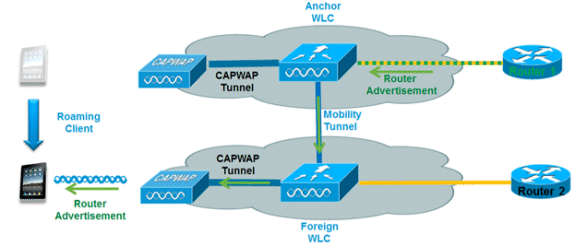
In order to deal with roaming IPv6 clients across controllers, the ICMPv6 messages such as Neighbor Solicitation (NS), Neighbor Advertisement (NA), Router Advertisement (RA), and Router Solicitation (RS) must be dealt with specially in order to ensure a client remains on the same Layer 3 network. The configuration for IPv6 mobility is the same as for IPv4 mobility and requires no separate software on the client side to achieve seamless roaming. The only required configuration is that the controllers must be part of the same mobility group/domain.
Here is the process for IPv6 client mobility across controllers:
-
If both controllers have access to the same VLAN the client was originally on, the roam is simply a Layer 2 roaming event where the client record is copied to the new controller and no traffic is tunneled back to the anchor controller.
-
If the second controller does not have access to the original VLAN the client was on, a Layer 3 roaming event will occur, meaning all traffic from the client must be tunneled via the mobility tunnel (Ethernet over IP) to the anchor controller.
-
In order to ensure the client retains its original IPv6 address, the RAs from the original VLAN are sent by the anchor controller to the foreign controller where they are delivered to the client using L2 unicast from the AP.
-
When the roamed client goes to renew its address via DHCPv6 or generate a new address via SLAAC, the RS, NA, and NS packets continue to be tunneled to the original VLAN so the client will receive an IPv6 address that is applicable to that VLAN.
-
Note: Mobility for IPv6-only clients is based on VLAN information. This means that IPv6-only client mobility is not supported on untagged VLANs.
Support for VLAN Select (Interface Groups)
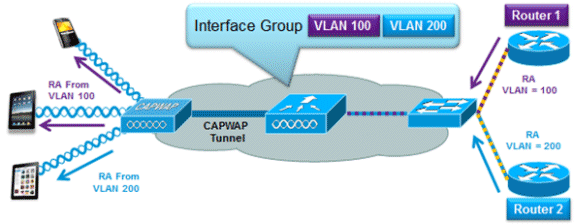
The interface groups feature allows an organization to have a single WLAN with multiple VLANs configured on the controller in order to permit load balancing of wireless clients across these VLANs. This feature is commonly used to keep IPv4 subnet sizes small while enabling a WLAN to scale to thousands of users across multiple VLANs in the group. In order to support IPv6 clients with interface groups, no additional configuration is required as the system automatically sends the correct RA to the correct clients via L2 wireless unicast. By unicasting the RA, clients on the same WLAN, but a different VLAN, do not receive the incorrect RA.
First Hop Security for IPv6 Clients
Router Advertisement Guard

The RA Guard feature increases the security of the IPv6 network by dropping RAs coming from wireless clients. Without this feature, misconfigured or malicious IPv6 clients could announce themselves as a router for the network, often with a high priority which could take precedence over legitimate IPv6 routers.
By default, RA Guard is enabled at the AP (but can be disabled at the AP) and is always enabled on the controller. Dropping RAs at the AP is preferred as it is a more scalable solution and provides enhanced per-client RA drop counters. In all cases, the IPv6 RA will be dropped at some point, protecting other wireless clients and upstream wired network from malicious or misconfigured IPv6 clients.
DHCPv6 Server Guard
The DHCPv6 Server Guard feature prevents wireless clients from handing out IPv6 addresses to other wireless clients or wired clients upstream. In order to prevent DHCPv6 addresses from being handed out, any DHCPv6 advertise packets from wireless clients are dropped. This feature operates on the controller, requires no configuration and is enabled automatically.
IPv6 Source Guard
The IPv6 Source Guard feature prevents a wireless client spoofing an IPv6 address of another client. This feature is analogous to IPv4 Source Guard. IPv6 Source Guard is enabled by default but can be disabled via the CLI.
IPv6 Address Accounting
For RADIUS authentication and accounting, the controller sends back one IP address using the “Framed-IP-address” attribute. The IPv4 address is used in this case.
The “Calling-Station-ID” attribute uses this algorithm in order to send back an IP address when the “Call Station ID Type” on the controller is configured to “IP Address”:
-
IPv4 address
-
Global Unicast IPv6 Address
-
Link Local IPv6 Address
Since client IPv6 addresses can change often (temporary or private addresses), it is important to track them over time. Cisco NCS records all IPv6 addresses in use by each client and historically logs them each time the client roams or establishes a new session. These records can be configured at NCS to be held for up to a year.
Note: The default value for the “Call Station ID Type” on the controller has been changed to “System MAC Address” in version 7.2. When upgrading, this should be changed to allow unique tracking of clients by MAC address as IPv6 addresses may change mid-session and cause issues in accounting if the Calling-Station-ID is set to IP address.
IPv6 Access Control Lists
In order to restrict access to certain upstream wired resources or block certain applications, IPv6 Access Control Lists (ACLs) can be used to identify traffic and permit or deny it. IPv6 ACLs support the same options as IPv4 ACLs including source, destination, source port, and destination port (port ranges are also supported). Pre-authentication ACLs are also supported to support IPv6 guest authentication using an external web server. The wireless controller supports up to 64 unique IPv6 ACLs with 64 unique rules in each. The wireless controller continues to support an additional 64 unique IPv4 ACLs with 64 unique rules in each for a total of 128 ACLs for a dual-stack client.
AAA Override for IPv6 ACLs
In order to support centralized access control through a centralized AAA server such as the Cisco Identity Services Engine (ISE) or ACS, the IPv6 ACL can be provisioned on a per-client basis using AAA Override attributes. In order to use this feature, the IPv6 ACL must be configured on the controller and the WLAN must be configured with the AAA Override feature enabled. The actual named AAA attribute for an IPv6 ACL is Airespace-IPv6-ACL-Name similar to the Airespace-ACL-Name attribute used for provisioning an IPv4-based ACL. The AAA attribute returned contents should be a string equal to the name of the IPv6 ACL as configured on the controller.
Packet Optimization for IPv6 Clients
Neighbor Discovery Caching
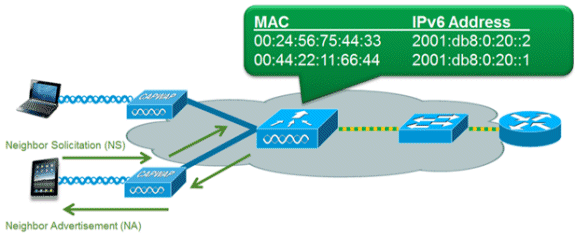
The IPv6 neighbor discovery protocol (NDP) utilizes NA and NS packets in place of Address Resolution Protocol (ARP) in order to allow IPv6 clients to resolve the MAC address of other clients on the network. The NDP process can be very chatty as it initially uses multicast addresses to perform address resolution; this can consume valuable wireless airtime as the multicast packets are sent to all clients on the network segment.
In order to increase the efficiency of the NDP process, neighbor discovery caching allows the controller to act as a proxy and respond back to NS queries that it can resolve. Neighbor discovery caching is made possible by the underlying neighbor binding table present in the controller. The neighbor binding table keeps track of each IPv6 address and its associated MAC address. When an IPv6 client attempts to resolve another client’s link layer address, the NS packet is intercepted by the controller which responds back with a NA packet.
Router Advertisement Throttling
Router Advertisement Throttling allows the controller to enforce rate limiting of RAs headed towards the wireless network. By enabling RA throttling, routers which are configured to send RAs very often (for example, every three seconds) can be trimmed back to a minimum frequency that will still maintain IPv6 client connectivity. This allows airtime to be optimized by reducing the number of multicast packets that must be sent. In all cases, if a client sends an RS, then an RA will be allowed through the controller and unicast to the requesting client. This is to ensure that new clients or roaming clients are not negatively impacted by RA throttling.
IPv6 Guest Acces
The wireless and wired guest features present for IPv4 clients work in the same manner for dual-stack and IPv6-only clients. Once the guest user associates, they are placed in a “WEB_AUTH_REQ” run state until the client is authenticated via the IPv4 or IPv6 captive portal. The controller will intercept both IPv4 and IPv6 HTTP/HTTPS traffic in this state and redirect it to the virtual IP address of the controller. Once the user is authenticated via the captive portal, their MAC address is moved to the run state and both IPv4 and IPv6 traffic is allowed to pass. For external web authentication, pre-authentication ACL allows an external web server to be used.
In order to support the redirection of IPv6-only clients, the controller automatically creates an IPv6 virtual address based off of the IPv4 virtual address configured on the controller. The virtual IPv6 address follows the convention of [::ffff:<virtual IPv4 address>]. For example, a virtual IP address of 1.1.1.1 would translate to [::ffff:1.1.1.1].
When using a trusted SSL certificate for guest access authentication, make sure that both the IPv4 and IPv6 virtual address of the controller is defined in DNS to match the SSL certificates hostname. This ensures that clients do not receive a security warning stating that the certificate does not match the hostname of the device.
Note: The controller’s auto-generated SSL certificate does not contain the IPv6 virtual address. This may cause some web browsers to present a security warning. Using a trusted SSL certificate for guest access is recommended.
IPv6 VideoStream

VideoStream enables reliable and scalable wireless multicast video delivery, sending each client the stream in a unicast format. The actual multicast to unicast conversion (of L2) occurs at the AP providing a scalable solution. The controller sends the IPv6 video traffic inside an IPv4 CAPWAP multicast tunnel which allows efficient network distribution to the AP.
IPv6 Quality of Service
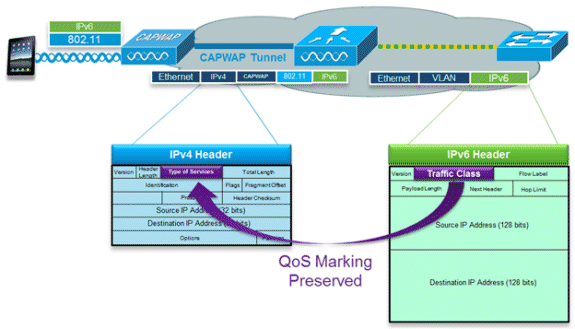
IPv6 packets use a similar marking to IPv4’s use of DSCP values supporting up to 64 different traffic classes (0-63). For downstream packets from the wired network, the IPv6 Traffic Class value is copied to the header of the CAPWAP tunnel in order to ensure that QoS is preserved end-to-end. In the upstream direction, the same occurs as client traffic marked at Layer 3 with IPv6 traffic class will be honored by marking the CAPWAP packets destined for the controller.
IPv6 and FlexConnect

FlexConnect – Local Switching WLANs
FlexConnect in local switching mode supports IPv6 clients by bridging the traffic to the local VLAN, similar to IPv4 operation. Client mobility is supported for Layer 2 roaming across the FlexConnect group.
These IPv6-specific features are supported in FlexConnect local switching mode:
-
IPv6 RA Guard
-
IPv6 Bridging
-
IPv6 Guest Authentication (controller-hosted)
These IPv6-specific features are not supported in FlexConnect local switching mode:
-
Layer 3 Mobility
-
IPv6 VideoStream
-
IPv6 Access Control Lists
-
IPv6 Source Guard
-
DHCPv6 Server Guard
-
Neighbor Discovery Caching
-
Router Advertisement Throttling
FlexConnect – Central Switching WLANs
For APs in FlexConnect mode using central switching (tunneling traffic back to the controller), the controller must be set to “Multicast - Unicast Mode” for the “AP Multicast Mode”. Since FlexConnect APs do not join the CAPWAP multicast group of the controller, multicast packets must be replicated at the controller and unicast to each AP individually. This method is less efficient than “Multicast - Multicast Mode” and places additional load on the controller.
This IPv6-specific feature is not supported in FlexConnect central switching mode:
-
IPv6 VideoStream
Note: Centrally switched WLANs running IPv6 are not supported on the Flex 7500 Series Controller.
IPv6 Clients Visibility with NCS
With the release of NCS v1.1, many additional IPv6 specific capabilities are added to monitor and manage a network of IPv6 clients on both wired and wireless networks.
IPv6 Dashboard Items
In order to view what types of clients are present on the network, a “Dashlet” in NCS is available in order to provide insight into IPv6 specific statistics and offer the capability to drill down into IPv6 clients.
IP Address Type Dashlet - Displays the types of IP clients on the network:
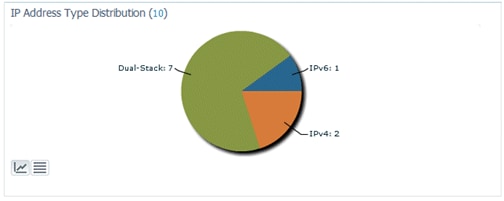
Client Count by IP Address Type - Displays the IP client type over time:
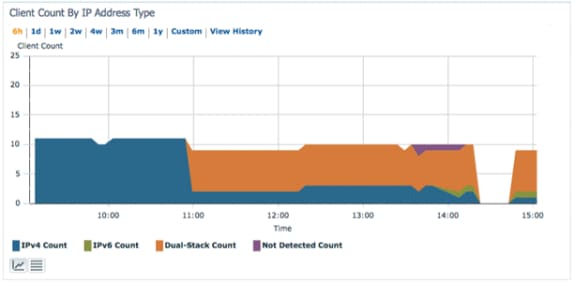
Client Traffic by IP Address Type - Displays the traffic from each type of client. Clients in the dual-stack category include both IPv4 and IPv6 traffic:
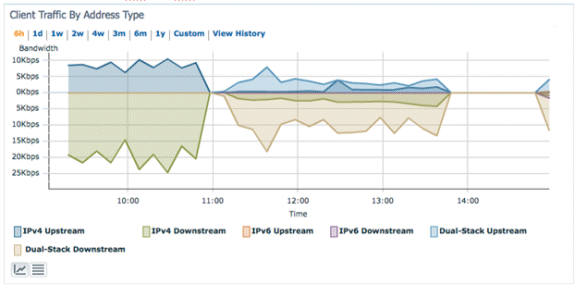
IPv6 Address Assignment - Displays the method of address assignment for each client as one of these four categories:
-
DHCPv6 - For clients with addresses assigned by a central server. The client may also have a SLAAC address as well.
-
SLAAC or Static - For clients using stateless address auto assignment or using statically configured addresses.
-
Unknown - In some cases, the IPv6 address assignment cannot be discovered.
-
This condition only occurs on wired clients in NCS as some switches do not snoop IPv6 address assignment information.
-
-
Self-Assigned - For clients with only a Link-local address which is entirely self-assigned.
-
Clients in this category can have IPv6 connectivity issues since they lack a Global Unique or Local Unique address.
-
Each of the sections of the pie chart is clickable, which allows the administrator to drill down to a list of clients.
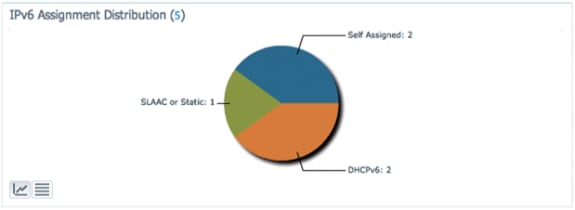
Monitor IPv6 Clients
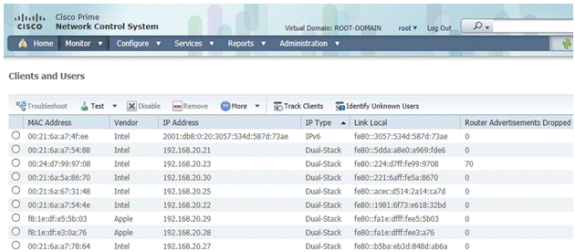
In order to monitor and manage IPv6 client information, these columns were added to the Clients and Users page:
-
IP Type - The type of client based on what IP addresses have been seen from the client. The possible options are IPv4, IPv6, or Dual-Stack which signifies a client with both IPv4 and IPv6 addresses.
-
IPv6 Assignment Type - The method of address assignment is detected by NCS as either SLAAC or Static, DHCPv6, Self-Assigned, or Unknown.
-
Global Unique - The most recent IPv6 global address used by the client. A mouse-over on column contents reveals any additional IPv6 global unique addresses used by the client.
-
Local Unique - The most recent IPv6 local unique address used by the client. A mouse over on column contents reveals any additional IPv6 global unique addresses used by the client.
-
Link Local - The IPv6 address of the client which is self-assigned and used for communication before any other IPv6 address is assigned.
-
Router Advertisements Dropped - The number of router advertisements sent by the client and dropped at the AP. This column can be used to track down clients that may be misconfigured or maliciously configured to act like an IPv6 router. This column is sortable, which allows offending clients to be identified easily.

In addition to displaying IPv6 specific columns, the IP Address column will show the current IP address of the client with a priority to display the IPv4 address first (in the case of a Dual-Stack client) or the IPv6 Global Unique address in the case of an IPv6-only client.
Configuration for Wireless IPv6 Client Support
Multicast Distribution Mode to APs
The Cisco Unified Wireless Network supports two methods of multicast distribution to APs associated to the controller. In both modes, the original multicast packet from the wired network is encapsulated inside a Layer 3 CAPWAP packet sent via either CAPWAP Unicast or Multicast to the AP. Since the traffic is CAPWAP encapsulated, APs do not have to be on the same VLAN as the client traffic. The two methods of Multicast distribution are compared here:
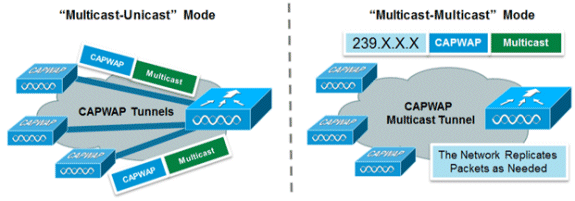
| Multicast-Unicast Mode | Multicast-Multicast Mode | |
|---|---|---|
| Delivery Mechanism | The controller replicates the multicast packet and sends it to each AP in a Unicast CAPWAP Tunnel | The controller sends one copy of the multicast packet |
| Supported AP Modes | FlexConnect and Local | Local Mode Only |
| Requires L3 Multicast Routing on Wired Network | No | Yes |
| Controller Loading | High | Low |
| Wired Network Loading | High | Low |
Configure Multicast-Multicast Distribution Mode
Multicast-multicast mode is the recommended option for scalability and wired bandwidth efficiency reasons.
Note: This step is only absolutely required for the 2500 Series Wireless Controller, but it enables more efficient multicast transmission and is recommended for all controller platforms.
Go to the “Controller” tab under the “General” page and make sure the AP Multicast Mode is configured to use Multicast mode and that a valid group address is configured. The group address is an IPv4 multicast group and is recommended to be in the 239.X.X.X-239.255.255.255 range, which is scoped for private multicast applications.
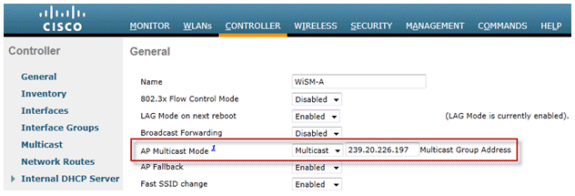
Note: Do not use the 224.X.X.X, 239.0.0.X, or the 239.128.0.X address ranges for the multicast group address. Addresses in these ranges overlap with the link local MAC addresses and flood all switch ports, even with IGMP snooping enabled.
Configure Multicast-Unicast Distribution Mode
If the wired network is not properly configured to deliver the CAPWAP multicast between the controller and AP or FlexConnect mode, and APs will be used for centrally switched WLANs supporting IPv6, then unicast mode is required.
-
Go to the Controller tab under the General page, and make sure the AP Multicast Mode is configured to use Unicast mode.

-
Connect an IPv6 capable client to the wireless LAN. Validate that the client receives an IPv6 address by navigating to the Monitor tab and then the Clients menu.
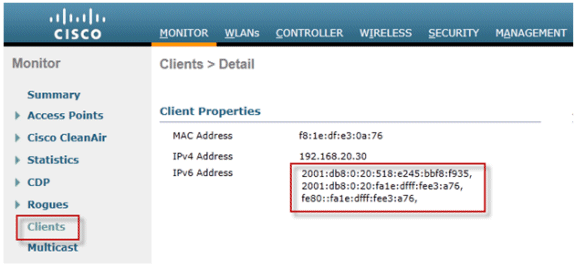
Configure IPv6 Mobility
There is no specific configuration for IPv6 mobility except to place controllers in the same mobility group or within the same mobility domain. This allows up to 72 total controllers to participate in a mobility domain providing seamless mobility for even the largest of campuses.
Go to the Controller tab > Mobility Groups, and add each controller by MAC Address and IP address into the group. This must be done on all controllers in the mobility group.
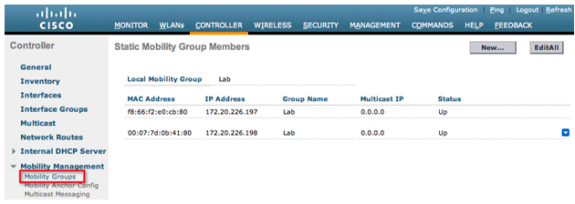
Configure IPv6 Multicast
The controller supports MLDv1 snooping for IPv6 multicast which allows it to intelligently keep track of and deliver multicast flows to clients that request them.
Note: Unlike previous versions of releases, IPv6 unicast traffic support does not mandate that “Global Multicast Mode” be enabled on the controller. IPv6 unicast traffic support is enabled automatically.
-
Go to the Controller tab > Multicast page and Enable MLD Snooping in order to support multicast IPv6 traffic. In order for IPv6 Multicast to be enabled, the Global Multicast Mode of the controller must be enabled as well.
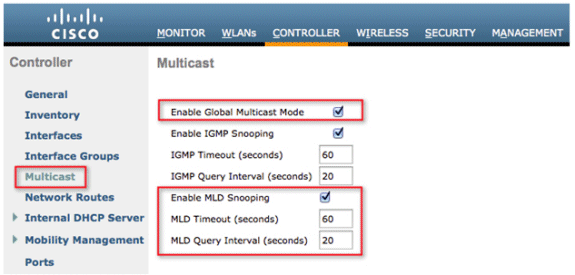
Note: Global Multicast Mode, IGMP, and MLD snooping should be enabled if peer-to-peer discovery applications such as Apple’s Bonjour are required.
-
In order to verify that IPv6 multicast traffic is being snooped, go to the Monitor tab and the Multicast page. Notice that both IPv4 (IGMP) and IPv6 (MLD) multicast groups are listed. Click the MGID in order to view the wireless clients joined to that group address.
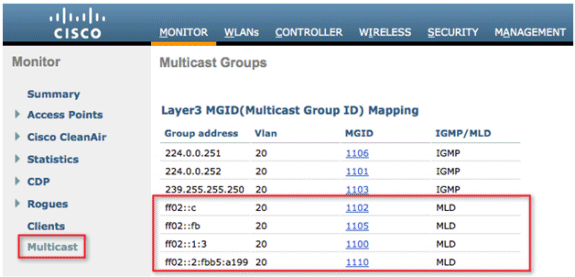
Configure IPv6 RA Guard
Navigate to the Controller tab and then IPv6 > RA Guard on the left-hand menu. Enable IPv6 RA Guard on AP. RA Guard on the controller cannot be disabled. In addition to RA Guard configuration, this page also showcases any clients that have been identified as sending RAs.
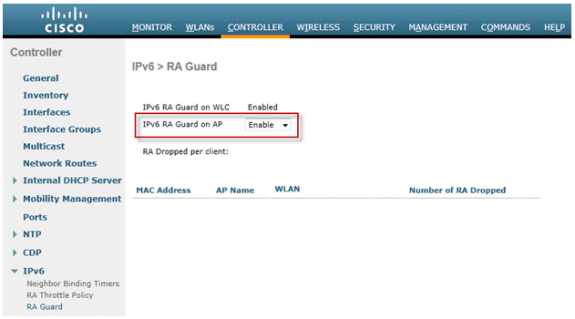
Configure IPv6 Access Control Lists
-
Go to the Security tab, open Access Control Lists, and click New.
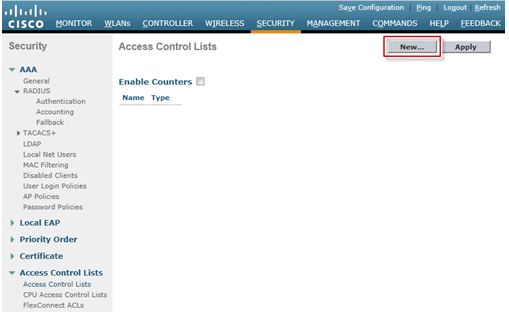
-
Enter a unique name for the ACL, change the ACL Type to IPv6, and click Apply.

-
Click on the new ACL that was created in the above steps.

-
Click Add New Rule, enter the desired parameters for the rule, and click Apply. Leave the sequence number blank in order to place the rule at the end of the list. The “Direction” option of “Inbound” is used for traffic coming from the wireless network, and “Outbound” for traffic destined for wireless clients. Remember, the last rule in an ACL is an implicit deny-all. Use a prefix length of 64 in order to match an entire IPv6 subnet, and a prefix length of 128 for uniquely restricting access to an individual address.
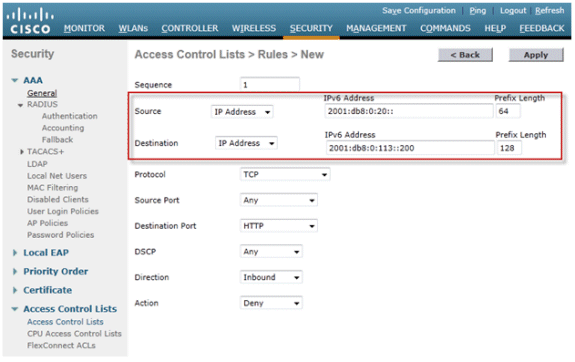
-
IPv6 ACLs are applied on a per-WLAN/SSID basis and can be used on multiple WLANs concurrently. Navigate to the WLANs tab and click the WLAN ID of the SSID in question in order to apply the IPv6 ACL. Click the Advanced tab and change the Override Interface ACL for IPv6 to the ACL name.
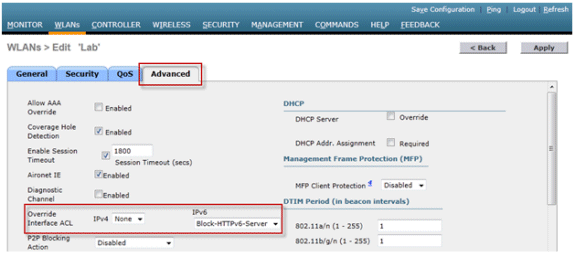
Configure IPv6 Guest Access for External Web Authentication
-
Configure the IPv4 and IPv6 pre-authentication ACL for the webserver. This allows traffic to and from the external server before the client is fully authenticated.
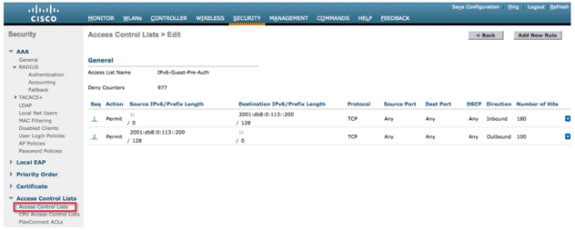
For more information on the operation of external web access, refer to External Web Authentication with Wireless LAN Controllers Configuration Example.
-
Configure the Guest WLAN by browsing to the WLANs tab at the top. Create the Guest SSID and use a Layer 3 web policy. The pre-authentication ACLs defined in Step 1 are selected for IPv4 and IPv6. Check the Over-ride Global Config section and select External from the Web Auth type drop-down box. Enter the URL of the web server. The host name of the external server should be resolvable in IPv4 and IPv6 DNS.
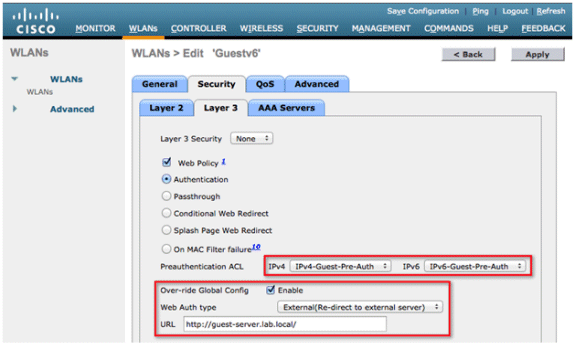
Configure IPv6 RA Throttling
-
Navigate to the Controller top-level menu and click the IPv6 > RA Throttle Policy option on the left-hand side. Enable RA Throttling by clicking the checkbox.
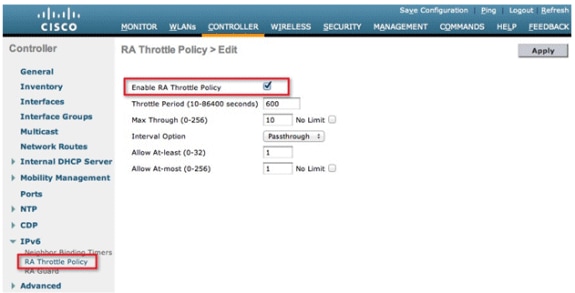
Note: When RA Throttling occurs, only the first IPv6 capable router is allowed through. For networks with multiple IPv6 prefixes being served by different routers, RA throttling should be disabled.
-
Adjust the throttle period and other options only under advisement from TAC. However, the default is recommended for most deployments. The various configuration options of the RA Throttling policy should be adjusted with this in mind:
-
The numerical values of “Allow At-least” should be less than “Allow At-most” which should be less than “Max Through”.
-
The RA throttle policy should not use a throttle period that is more than 1800 seconds as this is the default lifetime of most RAs.
-
Each RA Throttling option is described below:
-
Throttle Period - The period of time that throttling takes place. RA throttling takes effect only after the “Max Through” limit is reached for the VLAN.
-
Max Through - This is the maximum number of RAs per VLAN before throttling kicks in. The “No Limit” option allows an unlimited amount of RAs through with no throttling.
-
Interval Option - The interval option allows the controller to act differently based on the RFC 3775 value set in the IPv6 RA.
-
Passthrough - This value allows any RAs with an RFC3775 interval option to go through without throttling.
-
Ignore - This value will cause the RA throttler to treat packets with the interval option as a regular RA and subject to throttling if in effect.
-
Throttle - This value will cause the RAs with the interval option to always be subject to rate limiting.
-
-
Allow At-least - The minimum number of RAs per router that will be sent as multicast.
-
Allow At-most - The maximum number of RAs per router that will be sent as multicast before throttling takes effect. The “No Limit” option will allow an unlimited number of RAs through for that router.
Configure the IPv6 Neighbor Binding Table
-
Go to the Controller top-level menu and click IPv6 > Neighbor Binding Timers on the left-hand menu.
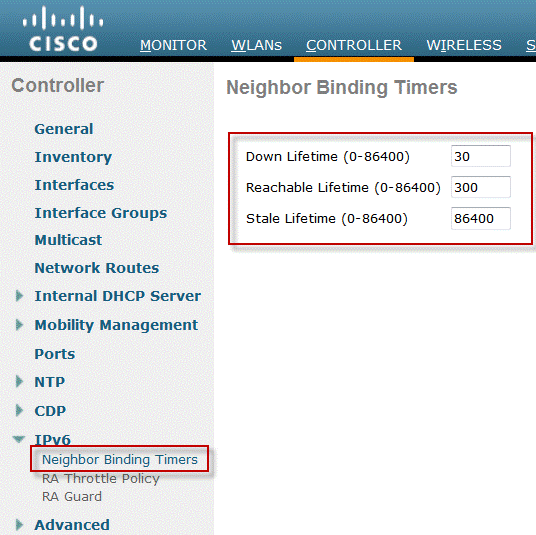
-
Adjust Down Lifetime, Reachable Lifetime, and Stale Lifetime as needed. For deployments with clients that are highly mobile, the timers for a stale address timer should be tweaked. Recommended values are:
-
Down Lifetime - 30 seconds
-
Reachable Lifetime - 300 seconds
-
State Lifetime - 86400 seconds
Each lifetime timer refers to the state that an IPv6 address can be in:
-
Down Lifetime - The down timer specifies how long IPv6 cache entries should be kept if the controller’s uplink interface goes down.
-
Reachable Lifetime - This timer specifies how long an IPv6 address will be marked active which means traffic has been received from this address recently. Once this timer expires, the address is moved to the “Stale” status.
-
Stale Lifetime - This timer specifies how long to keep IPv6 addresses in the cache which have not been seen within the “Reachable Lifetime”. After this lifetime, the address is removed from the binding table.
-
Configure IPv6 VideoStream
-
Ensure Global VideoStream features are enabled on the Controller. Refer to Cisco Unified Wireless Network Solution: VideoStream Deployment Guide for information on enabling VideoStream on the 802.11a/g/n network as well as the WLAN SSID.
-
Go to the Wireless tab on the controller, and on the left-hand menu, choose Media Stream > Streams. Click Add New in order to create a new stream.
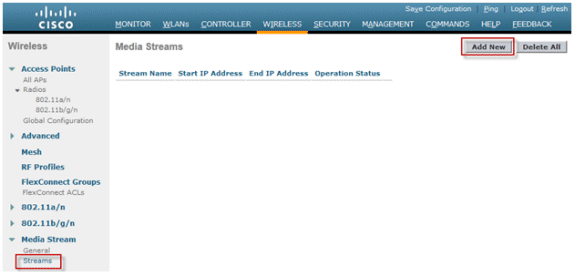
-
Name the stream and enter the start and end IPv6 addresses. When using only a single stream, the start and end addresses are equal. After adding the addresses, click Apply in order to create the stream.
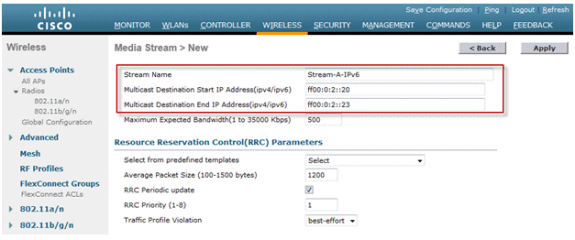
Troubleshoot IPv6 Client Connectivity
Certain Clients are Unable to Pass IPv6 Traffic
Some client IPv6 networking stack implementations do not properly announce themselves when coming onto the network and therefore their address is not snooped appropriately by the controller for placement in the neighbor binding table. Any addresses not present in the neighbor binding table are blocked according to the IPv6 source guard feature. In order to permit these clients to pass traffic, these options need to be configured:
-
Disable the IPv6 Source Guard Feature through the CLI:
config network ip-mac-binding disable
-
Enable Multicast Neighbor Solicitation Forwarding through the CLI:
config ipv6 ns-mcast-fwd enable
Verify Successful Layer 3 Roaming for an IPv6 Client:
Issue these debug commands on both the anchor and foreign controller:
debug client <mac address>
debug mobility handoff enable
debug mobility packet enable
Debug Results on Anchor Controller:
00:21:6a:a7:4f:ee 0.0.0.0 RUN (20) State Update from Mobility-Complete to Mobility-Incomplete 00:21:6a:a7:4f:ee 0.0.0.0 RUN (20) Setting handles to 0x00000000 00:21:6a:a7:4f:ee pemApfDeleteMobileStation2: APF_MS_PEM_WAIT_L2_AUTH_COMPLETE = 0. 00:21:6a:a7:4f:ee 0.0.0.0 RUN (20) Deleted mobile LWAPP rule on AP [04:fe:7f:49:03:30] 00:21:6a:a7:4f:ee Updated location for station old AP 04:fe:7f:49:03:30-1, new AP 00:00:00:00:00:00-0 00:21:6a:a7:4f:ee Stopping deletion of Mobile Station: (callerId: 42) 00:21:6a:a7:4f:ee 0.0.0.0 RUN (20) State Update from Mobility-Incomplete to Mobility-Complete, mobility role=Anchor, client state=APF_MS_STATE_ASSOCIATED 00:21:6a:a7:4f:ee 0.0.0.0 RUN (20) Change state to RUN (20) last state RUN (20) 00:21:6a:a7:4f:ee 0.0.0.0 RUN (20) Reached PLUMBFASTPATH: from line 4968 00:21:6a:a7:4f:ee 0.0.0.0 RUN (20) Adding Fast Path rule type = Airespace AP Client on AP 00:00:00:00:00:00, slot 0, interface = 13, QOS = 0 IPv4 ACL ID = 255, IPv6 ACL ID = 255, 00:21:6a:a7:4f:ee 0.0.0.0 RUN (20) Fast Path rule (contd...) 802.1P = 0, DSCP = 0, TokenID = 7006 Local Bridging Vlan = 20, Local Bridging intf id = 13 00:21:6a:a7:4f:ee 0.0.0.0 RUN (20) Successfully plumbed mobile rule (IPv4 ACL ID 255, IPv6 ACL ID 255) 00:21:6a:a7:4f:ee 0.0.0.0 Removed NPU entry. 00:21:6a:a7:4f:ee Set symmetric mobility tunnel for 00:21:6a:a7:4f:ee as in Anchor role 00:21:6a:a7:4f:ee 0.0.0.0 Added NPU entry of type 1, dtlFlags 0x1 00:21:6a:a7:4f:ee Pushing IPv6: fe80:0000:0000:0000: 3057:534d:587d:73ae , and MAC: 00:21:6A:A7:4F:EE , Binding to Data Plane. SUCCESS !! 00:21:6a:a7:4f:ee Pushing IPv6: 2001:0db8:0000:0020: 3057:534d:587d:73ae , and MAC: 00:21:6A:A7:4F:EE , Binding to Data Plane. SUCCESS !! 00:21:6a:a7:4f:ee 0.0.0.0, VLAN Id 20 Not sending gratuitous ARP 00:21:6a:a7:4f:ee Copy AP LOCP - mode:0 slotId:0, apMac 0x0:0:0:0:0:0 00:21:6a:a7:4f:ee Copy WLAN LOCP EssIndex:3 aid:0 ssid: Roam 00:21:6a:a7:4f:ee Copy Security LOCP ecypher:0x0 ptype:0x2, p:0x0, eaptype:0x6 w:0x1 aalg:0x0, PMState: RUN 00:21:6a:a7:4f:ee Copy 802.11 LOCP a:0x0 b:0x0 c:0x0 d:0x0 e:0x0 protocol2:0x5 statuscode 0, reasoncode 99, status 3 00:21:6a:a7:4f:ee Copy CCX LOCP 4 00:21:6a:a7:4f:ee Copy e2e LOCP 0x1 00:21:6a:a7:4f:ee Copy MobilityData LOCP status:2, anchorip:0xac14e2c6 00:21:6a:a7:4f:ee Copy IPv6 LOCP: fe80::3057:534d:587d:73ae
Debug Results on Foreign Controller:
00:21:6a:a7:4f:ee Adding mobile on LWAPP AP f0:25:72:3c:0f:20(1) 00:21:6a:a7:4f:ee Reassociation received from mobile on AP f0:25:72:3c:0f:20 00:21:6a:a7:4f:ee 0.0.0.0 START (0) Changing IPv4 ACL 'none' (ACL ID 255) ===> 'none' (ACL ID 255) --- (caller apf_policy.c:1697) 00:21:6a:a7:4f:ee 0.0.0.0 START (0) Changing IPv6 ACL 'none' (ACL ID 255) ===> 'none' (ACL ID 255) --- (caller apf_policy.c:1864) 00:21:6a:a7:4f:ee Applying site-specific Local Bridging override for station 00:21:6a:a7:4f:ee - vapId 3, site 'default-group', interface 'client-b1' 00:21:6a:a7:4f:ee Applying Local Bridging Interface Policy for station 00:21:6a:a7:4f:ee - vlan 25, interface id 12, interface 'client-b1' 00:21:6a:a7:4f:ee processSsidIE statusCode is 0 and status is 0 00:21:6a:a7:4f:ee processSsidIE ssid_done_flag is 0 finish_flag is 0 00:21:6a:a7:4f:ee STA - rates (8): 140 18 152 36 176 72 96 108 0 0 0 0 0 0 0 0 *apfMsConnTask_4: Jan 22 20:37:45.370: 00:21:6a:a7:4f:ee suppRates statusCode is 0 and gotSuppRatesElement is 1 00:21:6a:a7:4f:ee Processing RSN IE type 48, length 22 for mobile 00:21:6a:a7:4f:ee 00:21:6a:a7:4f:ee 0.0.0.0 START (0) Initializing policy 00:21:6a:a7:4f:ee 0.0.0.0 START (0) Change state to AUTHCHECK (2) last state AUTHCHECK (2) 00:21:6a:a7:4f:ee 0.0.0.0 AUTHCHECK (2) Change state to 8021X_REQD (3) last state 8021X_REQD (3) 00:21:6a:a7:4f:ee 0.0.0.0 8021X_REQD (3) DHCP Not required on AP f0:25:72:3c:0f:20 vapId 3 apVapId 3for this client 00:21:6a:a7:4f:ee Not Using WMM Compliance code qosCap 00 00:21:6a:a7:4f:ee 0.0.0.0 8021X_REQD (3) Plumbed mobile LWAPP rule on AP f0:25:72:3c:0f:20 vapId 3 apVapId 3 00:21:6a:a7:4f:ee apfMsAssoStateInc 00:21:6a:a7:4f:ee apfPemAddUser2 (apf_policy.c:268) Changing state for mobile 00:21:6a:a7:4f:ee on AP f0:25:72:3c:0f:20 from Idle to Associated 00:21:6a:a7:4f:ee Scheduling deletion of Mobile Station: (callerId: 49) in 1800 seconds 00:21:6a:a7:4f:ee Sending Assoc Response to station on BSSID f0:25:72:3c:0f:20 (status 0) ApVapId 3 Slot 1 00:21:6a:a7:4f:ee apfProcessAssocReq (apf_80211.c:6290) Changing state for mobile 00:21:6a:a7:4f:ee on AP f0:25:72:3c:0f:20 from Associated to Associated <…SNIP…> 00:21:6a:a7:4f:ee 0.0.0.0 8021X_REQD (3) Change state to L2AUTHCOMPLETE (4) last state L2AUTHCOMPLETE (4) 00:21:6a:a7:4f:ee 0.0.0.0 L2AUTHCOMPLETE (4) DHCP Not required on AP f0:25:72:3c:0f:20 vapId 3 apVapId 3for this client 00:21:6a:a7:4f:ee Not Using WMM Compliance code qosCap 00 00:21:6a:a7:4f:ee 0.0.0.0 L2AUTHCOMPLETE (4) Plumbed mobile LWAPP rule on AP f0:25:72:3c:0f:20 vapId 3 apVapId 3 00:21:6a:a7:4f:ee 0.0.0.0 L2AUTHCOMPLETE (4) Change state to DHCP_REQD (7) last state DHCP_REQD (7) 00:21:6a:a7:4f:ee 0.0.0.0 DHCP_REQD (7) pemAdvanceState2 5253, Adding TMP rule 00:21:6a:a7:4f:ee 0.0.0.0 DHCP_REQD (7) Adding Fast Path rule type = Airespace AP - Learn IP address on AP f0:25:72:3c:0f:20, slot 1, interface = 13, QOS = 0 IPv4 ACL ID = 255, IP 00:21:6a:a7:4f:ee 0.0.0.0 DHCP_REQD (7) Fast Path rule (contd...) 802.1P = 0, DSCP = 0, TokenID = 7006 Local Bridging Vlan = 25, Local Bridging intf id = 12 00:21:6a:a7:4f:ee 0.0.0.0 DHCP_REQD (7) Successfully plumbed mobile rule (IPv4 ACL ID 255, IPv6 ACL ID 255) 00:21:6a:a7:4f:ee Stopping retransmission timer for mobile 00:21:6a:a7:4f:ee 00:21:6a:a7:4f:ee 0.0.0.0 Added NPU entry of type 9, dtlFlags 0x0 00:21:6a:a7:4f:ee Sent an XID frame 00:21:6a:a7:4f:ee Username entry () already exists in name table, length = 253 00:21:6a:a7:4f:ee Username entry () created in mscb for mobile, length = 253 00:21:6a:a7:4f:ee Applying post-handoff policy for station 00:21:6a:a7:4f:ee - valid mask 0x1000 00:21:6a:a7:4f:ee QOS Level: -1, DSCP: -1, dot1p: -1, Data Avg: -1, realtime Avg: -1, Data Burst -1, Realtime Burst -1 00:21:6a:a7:4f:ee Session: -1, User session: -1, User elapsed -1 Interface: N/A, IPv4 ACL: N/A, IPv6 ACL: 00:21:6a:a7:4f:ee 0.0.0.0 DHCP_REQD (7) Change state to DHCP_REQD (7) last state DHCP_REQD (7) 00:21:6a:a7:4f:ee 0.0.0.0 DHCP_REQD (7) pemCreateMobilityState 6370, Adding TMP rule 00:21:6a:a7:4f:ee 0.0.0.0 DHCP_REQD (7) Replacing Fast Path rule type = Airespace AP - Learn IP address on AP f0:25:72:3c:0f:20, slot 1, interface = 13, QOS = 0 IPv4 ACL ID = 255, 00:21:6a:a7:4f:ee 0.0.0.0 DHCP_REQD (7) Fast Path rule (contd...) 802.1P = 0, DSCP = 0, TokenID = 7006 Local Bridging Vlan = 25, Local Bridging intf id = 12 00:21:6a:a7:4f:ee 0.0.0.0 DHCP_REQD (7) Successfully plumbed mobile rule (IPv4 ACL ID 255, IPv6 ACL ID 255) 00:21:6a:a7:4f:ee Scheduling deletion of Mobile Station: (callerId: 55) in 1800 seconds 00:21:6a:a7:4f:ee Pushing IPv6: fe80:0000:0000:0000: 3057:534d:587d:73ae , and MAC: 00:21:6A:A7:4F:EE , Binding to Data Plane. SUCCESS !! 00:21:6a:a7:4f:ee apfMsRunStateInc 00:21:6a:a7:4f:ee 0.0.0.0 DHCP_REQD (7) Change state to RUN (20) last state RUN (20) 00:21:6a:a7:4f:ee 0.0.0.0 RUN (20) Reached PLUMBFASTPATH: from line 5776 00:21:6a:a7:4f:ee 0.0.0.0 RUN (20) Change state to RUN (20) last state RUN (20) 00:21:6a:a7:4f:ee Pushing IPv6: 2001:0db8:0000:0020: 3057:534d:587d:73ae , and MAC: 00:21:6A:A7:4F:EE , Binding to Data Plane. SUCCESS !! 00:21:6a:a7:4f:ee 0.0.0.0 RUN (20) State Update from Mobility-Incomplete to Mobility-Complete, mobility role=Foreign, client state=APF_MS_STATE_ASSOCIATED 00:21:6a:a7:4f:ee 0.0.0.0 RUN (20) Change state to RUN (20) last state RUN (20) 00:21:6a:a7:4f:ee 0.0.0.0 RUN (20) Reached PLUMBFASTPATH: from line 4968 00:21:6a:a7:4f:ee 0.0.0.0 RUN (20) Replacing Fast Path rule type = Airespace AP Client on AP f0:25:72:3c:0f:20, slot 1, interface = 13, QOS = 0 IPv4 ACL ID = 255, IPv6 ACL ID = 25 00:21:6a:a7:4f:ee 0.0.0.0 RUN (20) Fast Path rule (contd...) 802.1P = 0, DSCP = 0, TokenID = 7006 Local Bridging Vlan = 25, Local Bridging intf id = 12 00:21:6a:a7:4f:ee 0.0.0.0 RUN (20) Successfully plumbed mobile rule (IPv4 ACL ID 255, IPv6 ACL ID 255) 00:21:6a:a7:4f:ee 0.0.0.0 Added NPU entry of type 9, dtlFlags 0x0 00:21:6a:a7:4f:ee Set symmetric mobility tunnel for 00:21:6a:a7:4f:ee as in Foreign role 00:21:6a:a7:4f:ee 0.0.0.0 Added NPU entry of type 1, dtlFlags 0x1 00:21:6a:a7:4f:ee Pushing IPv6: fe80:0000:0000:0000: 3057:534d:587d:73ae , and MAC: 00:21:6A:A7:4F:EE , Binding to Data Plane. SUCCESS !! 00:21:6a:a7:4f:ee Pushing IPv6: 2001:0db8:0000:0020: 3057:534d:587d:73ae , and MAC: 00:21:6A:A7:4F:EE , Binding to Data Plane. SUCCESS !! 00:21:6a:a7:4f:ee Copy AP LOCP - mode:0 slotId:1, apMac 0xf0:25:72:3c:f:20 00:21:6a:a7:4f:ee Copy WLAN LOCP EssIndex:3 aid:1 ssid: Roam 00:21:6a:a7:4f:ee Copy Security LOCP ecypher:0x0 ptype:0x2, p:0x0, eaptype:0x6 w:0x1 aalg:0x0, PMState: RUN 00:21:6a:a7:4f:ee Copy 802.11 LOCP a:0x0 b:0x0 c:0x0 d:0x0 e:0x0 protocol2:0x7 statuscode 0, reasoncode 99, status 3 00:21:6a:a7:4f:ee Copy CCX LOCP 4 00:21:6a:a7:4f:ee Copy e2e LOCP 0x1 00:21:6a:a7:4f:ee Copy MobilityData LOCP status:3, anchorip:0xac14e2c5 00:21:6a:a7:4f:ee Copy IPv6 LOCP: fe80::3057:534d:587d:73ae 00:21:6a:a7:4f:ee Copy IPv6 LOCP: 2001:db8:0:20:3057:534d:587d:73ae
Useful IPv6 CLI Commands:
Show ipv6 neighbor-binding summary
Debug ipv6 neighbor-binding filter client <Client MAC> enable
Debug ipv6 neighbor-binding filter errors enable
Frequently Asked Questions
Q: What is the optimum IPv6 prefix size in order to limit the broadcast domain?
A: Although an IPv6 subnet can be sub-divided below a /64, this configuration will break SLAAC and cause issues with client connectivity. If segmentation is needed in order to reduce the number of hosts, the Interface Groups feature can be used to load balance clients among different back-end VLANs, each using a different IPv6 prefix.
Q: Are there any scalability limitations when it comes to supporting IPv6 clients?
A: The major scalability limitation for IPv6 client support is the neighbor binding table which keeps track of all wireless client IPv6 addresses. This table is scaled per controller platform in order to support the maximum number of clients multiplied by eight (the maximum number of addresses per client). The addition of the IPv6 binding table can raise the memory usage of the controller up roughly 10-15% under full load, depending on the platform.
| Wireless Controller | Maximum Number of Clients | IPv6 Neighbor Binding Table Size |
|---|---|---|
| 2500 | 500 | 4,000 |
| 5500 | 7,000 | 56,000 |
| WiSM2 | 15,000 | 120,000 |
Q: What is the impact of IPv6 features on the controller's CPU and memory?
A: The impact is minimal as the CPU has multiple cores for processing the control plane. When tested with maximum supported clients, each with 8 IPv6 addresses, the CPU usage was below 30%, and memory usage was below 75%.
Q: Can IPv6 client support be disabled?
A: For customers who want to enable only IPv4 in their network and block IPv6, an IPv6 ACL of deny-all traffic can be used and applied on a per-WLAN basis.
Q: Is it possible to have one WLAN for IPv4 and another for IPv6?
A: It is not possible to have the same SSID name and security type for two different WLANs operating on the same AP. For segmentation of IPv4 clients from IPv6 clients, two WLANs must be created. Each WLAN must be configured with an ACL that blocks all IPv4 or IPv6 traffic respectively.
Q: Why is it important to support multiple IPv6 addresses per client?
A: Clients can have multiple IPv6 addresses per interface which can be static, SLAAC or DHCPv6 assigned in addition to always having a self-assigned Link-Local address. Clients can also have additional addresses using different IPv6 prefixes.
Q: What are IPv6 private addresses and why are they important to track?
A: Private (also known as temporary) addresses are randomly generated by the client when SLAAC address assignment is in use. These addresses are often rotated at a frequency of a day or so, as to prevent host traceability that would come from using the same host postfix (last 64 bits) at all times. It is important to track these private addresses for auditing purposes such as tracing copyright infringement. Cisco NCS records all IPv6 addresses in use by each client and historically logs them each time the client roams or establishes a new session. These records can be configured at NCS to be held for up to a year.
Related Information
Revision History
| Revision | Publish Date | Comments |
|---|---|---|
1.0 |
31-Jan-2012 |
Initial Release |
Contact Cisco
- Open a Support Case

- (Requires a Cisco Service Contract)
 Feedback
Feedback